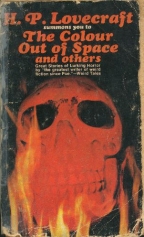
My original copy of Lovecraft's the Colour Our of Space, from 1969
|
|
|
The Agony Column for August 18, 1999
"Perhaps you could pursuade the Great Grand Master of Pomposity Mr. Kleffel to grab a torch and slip down here into the cellar for a moment, if for nothing else than to explain his aversion to popular American horror." - Matt on Masters of Terror board 'The Cellar'
"…the arrogant, pompous ramblings of Rick Kleffel… Change is bad. We must fear change." &emdash; Anonymous on Masters of Terror board 'The Cellar'
"Alleged Comments"?...go read the Agony Column. I just want to know why MOT now carries a column that insults American writers and publishers…" -- Anonymous on Masters of Terror board 'The Cellar'
"…Kleffel's dogma…" - Matt on Masters of Terror board 'The Cellar' again

My original copy of Lovecraft's the Colour Our of Space, from 1969
I discovered horror in the revolving rack of cheap paperbacks in a seedy liquor store in downtown Covina, California in 1971. I had finished reading all the stories in a gaudily covered Groff Conklin paperback titled 'The 17 Greatest Science Fiction Stories'. In an appendix, one of the recommendations was H. P. Lovecraft's 'The Color Out of Space'. And there, on the rack next to Mickey Spillane paperbacks that featured women about to burst out of what little clothing they were wearing was a skull enshrouded in flames, a Lancer paperback edition of 'The Color Out of Space and Others'. It seemed nearly as hazardous as the Spillane books, but just a hair more acceptable to bring home. I bought it. It was the first step down a long dark path that lead through many grocery stores and drugstores in the suburban wilderness of Southern California.
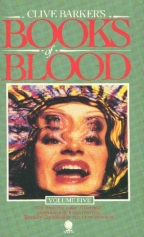
Clive Barker's Books of Blood hovered over my head in a Pasadena Bookstore
Fourteen years later, I was standing in a drug store in Pasadena California that for some reason carried British paperbacks. There in institutional green were six books that featured wobbly hands and faces and the lurid name of 'Books of Blood'. They were numbered. Could that be a good sign?
Then there was the all-foil cover of the book upon which the latest Stanley Kubrick film would be based. Who was this Stephen King guy anyway? Was Kubrick going to make the '2001' of horror? We all know the answer to that one.
Here in the US -- and in the UK for that matter -- publishers have long decided that the best way to sell horror novels in the mass market is to issue them in small print run paperbacks with virtually no publicity, little distribution and the gaudiest covers this side of the Harlequin Romance line. The result is low sales, lost opportunities and an image of the horror genre as a childish refuge for bored housewives and hormone overdosed adolescents. It also makes it a lot harder for the average horror fan to find a decent read. One never knows what's behind the foil. The sad lesson we must all continually learn and re-learn is that you can't judge a book by its cover.
This was brought home to me as I opened my third package from the Leisure Horror Book club. Following the unfortunate demise of Abyss line, it seemed almost impossible that any publisher would dare to use the horror genre to launch an imprint. But Leisure Books, publisher of some of the gaudiest and cheesiest horror novels ever sold in grocery stores, was not only going to produce a horror imprint, they were promising to publish some rather important, edgy and critically acclaimed writers out of the small press. This had to be a good thing.
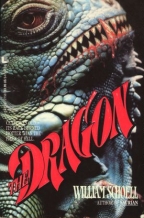
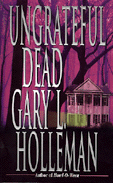
Serious genre fans tend to dismiss grocery store fiction as unimportant, but that is clearly not the case. It's the canary in the coal mine. If you're not seeing a lot of shiny paperbacks when you're out picking up a quart of milk and a pound of hamburger, that's an indication that you're not likely to find those edgy authors in the independent bookstore we know you all prefer to patronize. And there's nothing wrong with a really silly book to read now and again. Take for example Leisure's own William Schoell. 'Dragon' has a cover that will send you running in terror. The colorized iguana is like something that a 12-year-old Ray Harryhausen wannabe might create on his computer in his spare time. But behind that foil is one heck of a fun novel. In their latest incarnation, Leisure has surely not spared the cheese. But even a minor work like Gary Holleman's 'Ungrateful Dead' can be fun entertainment. Most of us don't want to read Great Literature all of the time.
The Early Simon Clark covers versus...
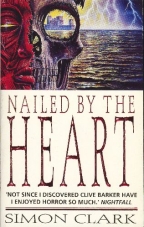

And never let it be said that American publishers are the only ones guilty of guilding the garbage and the great. British superstar Simon Clarke was not particularly well served by his cover art, until the release of 'Vampyrrhic'. For every US grossout cover, there's certainly bound to be a UK equivalent.
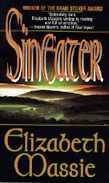

But horror readers have to learn to look beyond the foil. Leisure has sent out some fluff. And in practically the same breath, we got Elizabeth Massie's Stoker-award winning 'Sineater', a complex and well-written novel of terror. But then, the Stoker's don't always portend the best quality. Witness Owl Goingback's 'Crota'. You've got your unstoppable monster, some excellent research and not a whole lot more. Sure, like 'Dragon', it's fun stuff, but not exactly A-level material.
...and the fact that the cheesy cover was even ripped
off from another cheesy cover didn't help

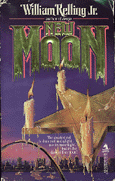
Then there was Tom Piccirilli. I'd read a bit of his work long ago in 'Grue' magazine, and found it was most excellent. I was really looking forward to getting his book, advertised when I joined up with LHBC. My enthusiasm withered when I opened the package and saw the cover -- practically a duplicate of another fun grocery store book I bought 12 years ago. And darn if the author of that book, William Relling Jr. didn't pretty much fall off the face of the earth after writing three decent novels and a collection of short stories for Scream/Press that was never published. This duplication of covers could not be a good sign. It was with great trepidation that I start 'Hexes', and it was with great surprise that I realized that Piccirilli could really, really write, with passion, power and occasionally precision. Now 'Hexes' was by no means perfect, but it was the kind of discovery that makes grocery store fiction so much fun. When you pick up a book with your burger, you're not expecting Shakespeare. In fact, you don't want anything like Shakespeare. But if that book turns out to particularly well written and evocative, like Piccirilli's 'Hexes', then American Cheese has served it's greater purpose, to sneak in an unexpected bit of quality and invention under the guise of cheap entertainment.
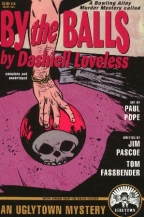
Cheesy with intent.
Some cheap entertainment means to be little more than that. Even as I was writing this column, a piece of deliberately created American Cheese arrived in my mailbox, courtesy Ziesing. This was 'By the Balls', a loving and wonderful re-creation of the kind of paperbacks that used to share the racks with that old H. P. Lovecraft collection. Ostensibly by 'Dashiell Loveless', 'By the Balls' is written by Amazon reviewer Jim Pascoe and Tom Fassbender, with interior and cover art by Paul Pope. It describes itself as an "Uglytown Mystery (with Crime map on the back cover)." 'By the Balls' truly captures the full feeling of prime American Cheese and runs with it from cover to cover. Interestingly enough, this book was born as a daily serial featured on the Internet.
Of course, since the pre-stated moral of this story is not to judge a book by its cover, we have to look at the other side of the spectrum. Remember those nicely designed really edgy novels by Abyss? There were a number of wonderful novels published with edgy covers (Kathe Koja's 'The Cipher' and Brian Hodge's 'Nightlife'), and particularly cheesy novels in the same line with equally hip cover art (Ron Dee's 'Dusk'). That line didn't last too long, unfortunately. And even with the hip covers, the cheese to literature ratio wasn't a whole lot higher than we're seeing in the Leisure line.
Then of course there are the quality hardcover original first editions that look like the bee's knees but pan out to be well -- certainly no better than Stoker-award winning cheese. The culprit in this case is James Byron Huggins' 'Hunter', which, like 'Crota', features an unstoppable monster and a man driven to hunt it down and kill it. Nice cover of a bigfoot-like footprint. And it's appropriate, since the monster is something like Bigfoot on PCP. Huggins writes an exciting novel if you can get past the velveeta effect. Many readers will be turned off by highly processed cheese. But, if you liked 'Crota', you'll love 'Hunter'. Of course, if you want something that takes a very similar idea but uses it to develop characters instead of killing machines, you'll have to look for Ray Garton's 'Biofire' from Cemetery Dance. And if you dig cheese, you love the slab'o'brain cover that conceals another butt-kicking tale of terror from one of America's most under-noticed horror writers.
There's another side to this cheese business though. It's the writer's nightmares. You think these guys are horror writers because it pays well? Think again. There's an old trap in the music business that has sunk a number of viable artists. It works like this. You shop your demo around and get a record contract. The label says, "This material is great. Let's put you in a studio and record an album! Use this one, it's the top hit factory." So you go in, and with the encouragement of the record company spend endless hours perfecting your first masterpiece. Then they press the record. If you have a hit, well, great. Maybe. As long as you make enough money to pay back the record company the $500-$1000 per hour you can spend in a top-notch studio. By the time you've completed your masterpiece, you owe them more money than you're likely to make from selling your record, unless it's a number one hit.
Some publishers have a similar scam. They advance a writer money, then if they're not certain the book is going to be number one with a bullet, well, they don't print enough copies to ensure that the author can earn his advance. So, your book goes unnoticed, and you pay for the privilege. One writer told me that "About the only thing I can think of that might compare to 'the [paperback publisher] experience' would be having my dick nailed to the side of a space shuttle just before take-off." Yikes. No wonder they're horror writers.
So when you see that foil covered abomination in the grocery store, don't just dismiss it with the adumbration that "All horror is just grocery store fiction!", or "All grocery store fiction is just crap!" That monstrosity might very well be the first edition of a book that collectors will kill for ten years from now. And even if the book is just empty fun, well, empty fun has its place in the publishing world and the reading world. Those award winners may not prove to be so hot. Or, they may be deeply affecting works of art. To figure out which it is, you'll have to read it, or find a reviewer you trust. There's no single easy answer. American Cheese is helpful and hurtful, good and bad. That hardcover with all the acclaim may be little more than a bad Sylvester Stallone movie in larval form. Do you see that book in the grocery store rack, by the horror author you read about in 'Masters of Terror'? Buy it, buy it from the grocery store, because that's the place where authors are created and destroyed. If they can sell at Safeway, they can sell anywhere.